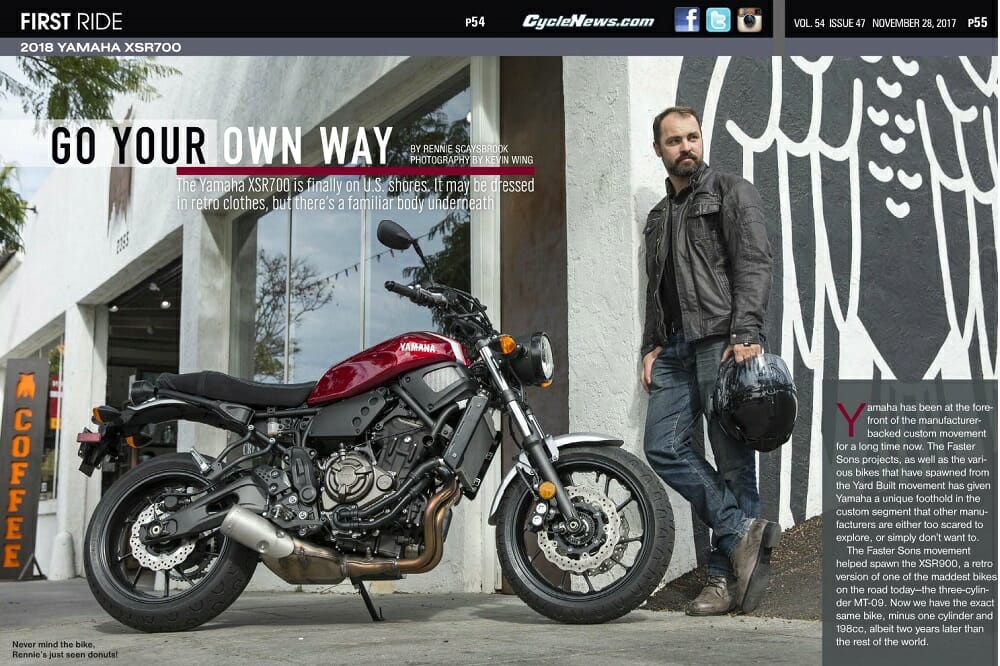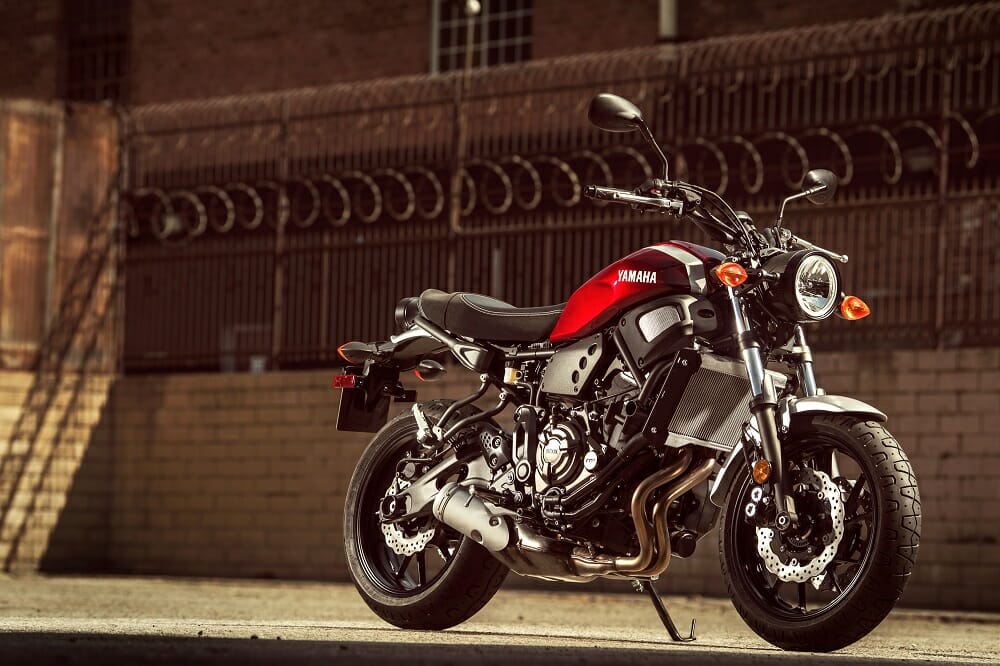Rennie Scaysbrook | November 30, 2017
The Yamaha XSR700 is finally on U.S. shores. It may be dressed in retro clothes, but there’s a familiar body underneath.
 Never mind the bike, Rennie’s just seen donuts!
Never mind the bike, Rennie’s just seen donuts!
Yamaha has been at the forefront of the manufacturer-backed custom movement for a long time now. The Faster Sons projects, as well as the various bikes that have spawned from the Yard Built movement has given Yamaha a unique foothold in the custom segment that other manufacturers are either too scared to explore, or simply don’t want to.

Click here to read this in the Cycle News Digital Edition Magazine.
Photography by Kevin Wing
The Faster Sons movement helped spawn the XSR900, a retro version of one of the maddest bikes on the road today in the three-cylinder MT-09. Now we have the exact same bike, minus one cylinder and 198cc, albeit two years later than the rest of the world.
 Even for a rider of Rennie’s 6’1,” the XSR700 is a very comfortable fit.
Even for a rider of Rennie’s 6’1,” the XSR700 is a very comfortable fit.
The XSR700 actually debuted in 2016 in Europe and Australasia, and only now have we seen it get the stamp of approval for the U.S. market. The reason being is the bikes running around in Europe were made in the European factory, whereas the bikes we have in the States come direct from Yamaha Japan. Yamaha Europe is one of the largest volume sellers of the brand in the world, and thus were “tooled up” to build the XSR before Yamaha Japan. It’s only in the last 12 months that Yamaha Japan has had the required tooling to build the bikes from scratch, hence the two-year wait for the U.S. market to get their XSR700s.
 Rear subframe comes off and voila, you’ve got yourself a custom bike!
Rear subframe comes off and voila, you’ve got yourself a custom bike!
Tardiness aside, it’s indeed a good thing the $8499 XSR700 is finally here. This is a bike spawned directly from the MT-07, a bike that represents some of—if not the—best value for money in the middleweight sector. The MT retails for a lovely $7599, packing with it one of the most enjoyable, bratty little motors and minimalist, edgy styling. It’s a teenager’s dream bike (or at least, it should be).
 The light sticks out quite a distance when viewed from the cockpit compared to more modern nakedbike designs.
The light sticks out quite a distance when viewed from the cockpit compared to more modern nakedbike designs.
The XSR takes everything that makes the MT so great and gives it a touch of sophistication, a little touch of class, if you will. Taking the same bodywork as the 900, the XSR700 gets different colors in the admittedly boring Matte Gray and Aluminum color scheme, with the Raspberry Metallic version our pick of the two. ABS comes standard fitment, but there’s no traction control, no quickshifter, no alternate riding modes. You don’t need that stuff on an XSR, anyway!
 Point the XSR in the twisties and watch that baby go!
Point the XSR in the twisties and watch that baby go!
Nestled between the XSR’s frame rails is the same delightfully bonkers 689cc parallel-twin four-stroke motor that has won so many fans in the MT-07—it’s a small, light power unit that has a seriously surprising amount of punch and makes you question whether this is indeed a 689cc and not an 889cc engine. The suspension is the same as the MT—save for slightly heavier fork and shock springs—and the rear subframe has been altered to house a much flatter, retro style seat. You can also detach the back-end and turn your 700 into a single seater. Neat.
 Front guard is designed to be easily detachable/modified.
Front guard is designed to be easily detachable/modified.
Where the XSR differs even more than the MT is Yamaha really, really wants you to put your own mark on the design. That doesn’t mean taking a hacksaw and buggering the thing irreparably, but in more sedate ways. Like paint. The two-piece tank cover is just that, a cover, with the real tank hidden beneath. As a result, for $134.99 you can buy as many covers as you like, changing colors and styles as often as you change your underwear. There are so many more parts available in the Yamaha parts range that allow you to change up your XSR depending on your mood. Clip-on bars, engine guards, mini screens, radiator guards, fork gaiters, flat seats, whatever. We can’t all be craftsmen like Jeff Palhegyi or JvB Moto, but that’s not to say they can have all the fun, right?
 These are all the bits you can change and play around with on your XSR. Not a bad selection from Yamaha!
These are all the bits you can change and play around with on your XSR. Not a bad selection from Yamaha!
But under all that façade, the XSR is still essentially an MT-07—which is a good thing indeed. The XSR doesn’t feel any different when you’re riding it, save for the flatter seat and slightly higher tank/cover shape. The motor still retains that amazing bottom-end punch off corners and doesn’t transmit too much vibration back to the rider. Interestingly, one of the defining features of an MT-07 is its (very) rubber-mounted handlebar. It’s so rubber mounted you can move it an inch fore and aft, which seriously dumbs down the vibration felt by the rider. The XSR’s bar is rubber mounted, but nothing to the degree of the MT, so Yamaha has almost contradicted their own argument there.
The little twin will produce its best power between 4-8000 rpm, but it’ll still pull with decent vigor right up to the 10 grand redline. Its fueling is superb for the most part, although there’s a bit of a hesitation from a closed throttle in hairpin/bottom gear corners. It’s a small trade-off as the rest of the engine package is extremely good.
 Lovely neat back-end has the XSR logo embossed into the seat.
Lovely neat back-end has the XSR logo embossed into the seat.
The ride is a little more taught than the MT thanks to the slightly heavier spring set-up, which ironically allows you to push a bit harder when you hit the canyons than the MT. You can really boss an XSR around and the Yam will happily play along, and it’s surprising how much grip the retro-themed Pirelli Phantom rubber will give you when it’s time for some fun.
The overall ride is still pretty soft, mind you, which makes long days in the saddle a cinch with the XSR. The flat and wide seat is a comfort improvement over the racier version you’ll find on the MT-07, as well as looking much nicer with the leather embossment of the XSR logo at the rear as it sits just behind the ’70s-esque round brake light.
 Make no mistake, that little CP2 motor is an absolute gem.
Make no mistake, that little CP2 motor is an absolute gem.
You’re paying a little more for the premium of an XSR700 over the MT-07 but you get a far more stylish machine for the money. While the MT can look a little plastic, the XSR has a genuinely classy feel to the design—even if underneath it’s basically the same bike.
It would be a touch lazy for an XSR buyer not to leave some form of customization mark on their machine, considering how Yamaha has designed the bike to make this aspect of ownership as easy as possible (hey, if you need a bit of inspiration, click HERE).
 The grey color scheme is a touch boring compared to the red, but that just means you should break out the paint and make it your own!
The grey color scheme is a touch boring compared to the red, but that just means you should break out the paint and make it your own!
Yamaha built this bike in the style of one of their most iconic designs in the XS-2 of the early 1970s. It was a machine that put Yamaha on the map as a serious alternative when it came to personal mobility, and while the XSR700 may not have a quite that legacy when its long gone, it’s still a nice little nod to the company’s past while giving a today’s rider all the fruit we’ve come to know, love and expect. CN

|
SPECIFICATIONS: 2018 Yamaha XSR700
|
|
MSRP:
|
$8,499
|
|
Engine:
|
Liquid-cooled DOHC inline twin-cylinder, eight valves
|
|
Displacement:
|
689cc
|
|
Bore x stroke:
|
80 x 68.6mm
|
|
Compression ratio:
|
11.5:1
|
|
Clutch:
|
Wet multi-plate
|
|
Transmission:
|
6-speed
|
|
Chassis:
|
Tubular steel
|
|
Front suspension:
|
41mm inverted fork
|
|
Rear suspension:
|
Single shock absorber, preload adjustable
|
|
Front wheel travel:
|
5.1 in.
|
|
Rear wheel travel:
|
5.1 in
|
|
Front brake:
|
Four-piston calipers, ABS as standard
|
|
Rear brake:
|
Twin-piston caliper, ABS as standard
|
|
Front tire:
|
120/70ZR17 Pirelli Phantom Sportcomp
|
|
Rear tire:
|
180/55ZR17 Pirelli Phantom Sportcomp
|
|
Rake:
|
25°
|
|
Wheelbase:
|
55.3 in.
|
|
Seat height:
|
32.1 in.
|
|
Fuel capacity:
|
3.7 gal.
|
|
Weight:
|
410 lbs. (wet, claimed).
|
|
Color:
|
Matte Gray/Aluminum; Raspberry Metallic
|